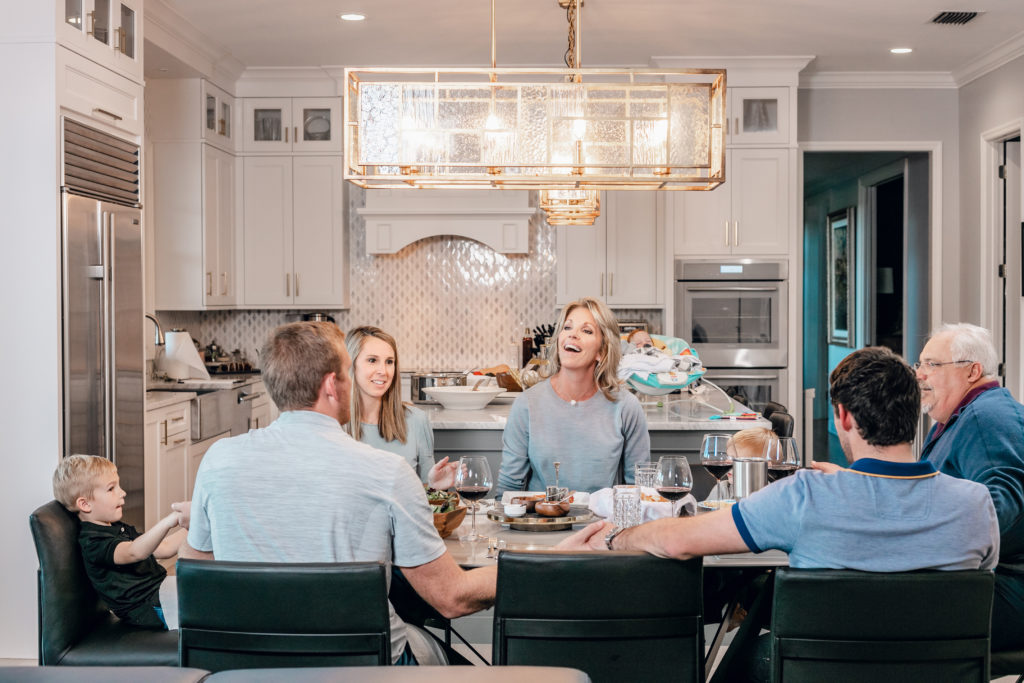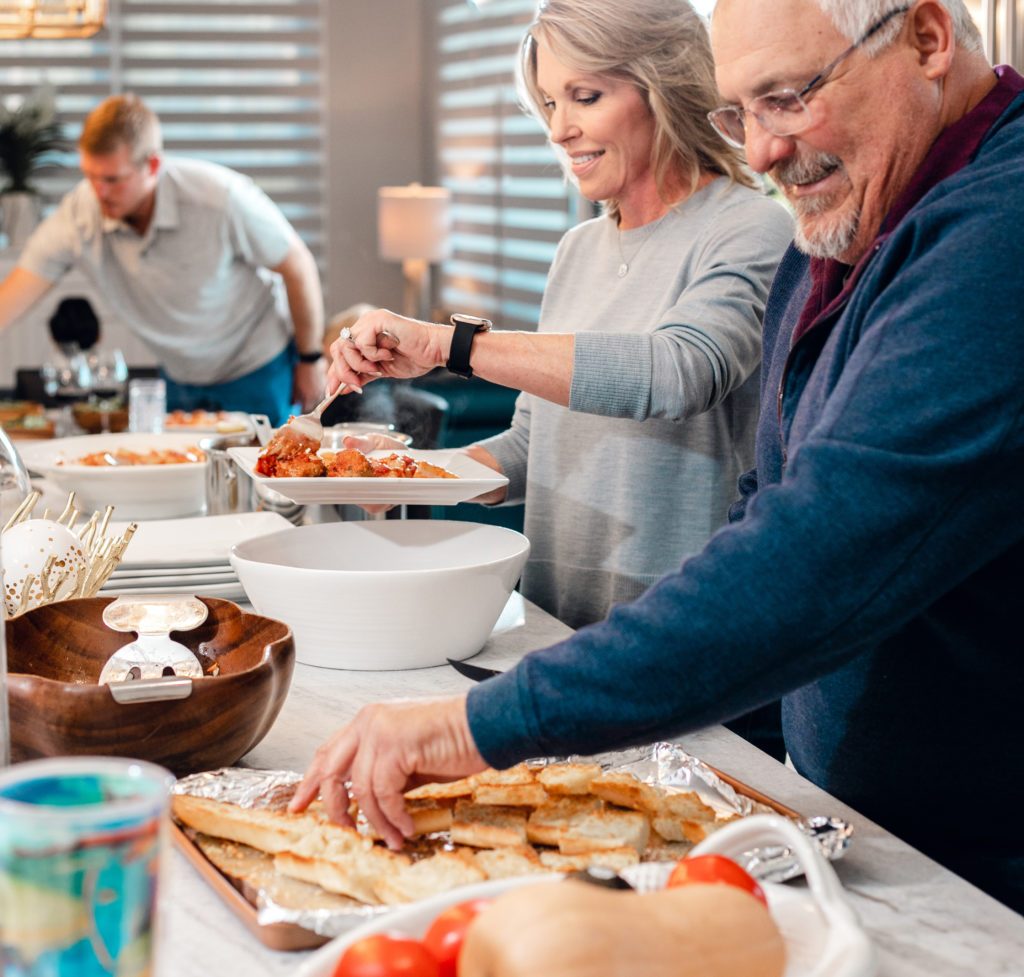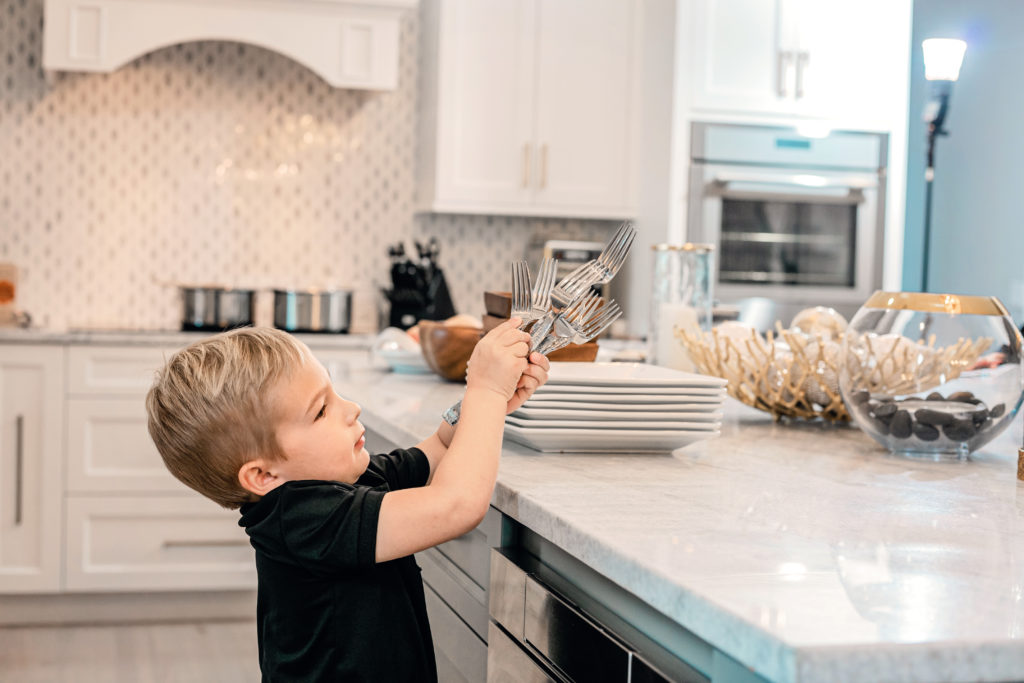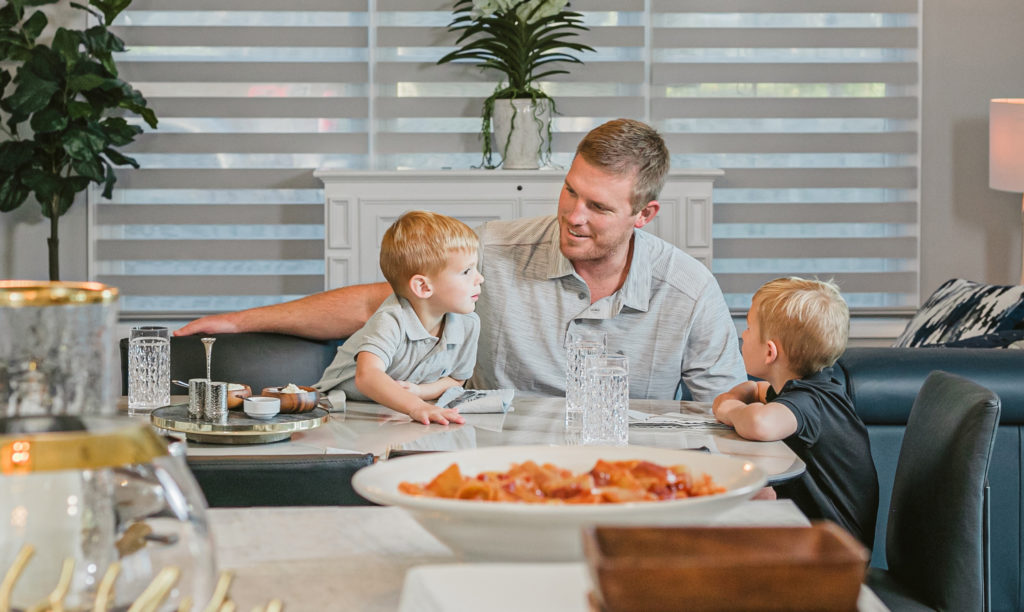It is a sacred tradition, an opportunity for communion with those we hold dear and an essential part of what shapes our children—it also seems to be in jeopardy of becoming a lost art.
 There is something about a shared meal that anchors a family. And I don’t mean those big holiday blowouts or some “once in a while” thing. I mean regularly and reliably—even on those nights when the food is fast and everyone has someplace else they’d rather be.
There is something about a shared meal that anchors a family. And I don’t mean those big holiday blowouts or some “once in a while” thing. I mean regularly and reliably—even on those nights when the food is fast and everyone has someplace else they’d rather be.
And then there are those evenings when the mood is right and the family lingers, caught up in an idea or an argument—explored in a shared safe place where no one is stupid or shy or ashamed—that you get a glimpse of the power of this habit and why social scientists say that such communion acts as a kind of vaccine, protecting kids from all manner of harm.
Yet, over and over we read that the family dinner is in decline. And there are likely hundreds of reasons, such as parents who work long hours to keep the mortgage paid, a decline in cooking skills, the popularity of fast food and increasingly irregular schedules. I suspect, however, that we’ve simply fallen out of practice.
Family dinners can end up playing a small, but crucial, part of family life. I believe the family dinner has the power to cure all kinds of ills and help navigate problems. Not everything, though. Heaven knows, family dinners didn’t keep me out of trouble as a strong-willed child. During those years in the ‘60s and ‘70s, there were very few nights that I was anxious for our family dinner, but it was still an important part of our routine. At our table, we were never allowed to take a bite before my mother sat down, because, most of the time, she made dinner and that was the respect we paid to her.
Family dinners don’t have to look like they are sometimes portrayed on television or in movies, of course. Maybe both mom and dad can’t be at the table. Maybe the family is a mom or dad and a child, a couple or a family of any sort or incarnation. Maybe it’s grandpa bringing home some chicken and biscuits from Kentucky Fried Chicken.
 The important part is the regular-ish timing of it. It’s the setting of the table and the sitting down to a meal on plates, whether it came out of an oven or a bucket…even if it is peanut butter sandwiches and milk. It’s the conversation (What was the highlight of your day? Did anything interesting happen today?) and the attempts to just be present for each other, even if everybody would rather be holed up in their rooms in front of the television screen or a gaming console.
The important part is the regular-ish timing of it. It’s the setting of the table and the sitting down to a meal on plates, whether it came out of an oven or a bucket…even if it is peanut butter sandwiches and milk. It’s the conversation (What was the highlight of your day? Did anything interesting happen today?) and the attempts to just be present for each other, even if everybody would rather be holed up in their rooms in front of the television screen or a gaming console.
Small Bites
For the littlest family members, sharing a dinner at the table with their parents has several benefits. First, it helps promote language skills. It also helps them develop patience and dexterity, through the use of utensils. And, it helps them develop social skills, including good manners and the discipline of taking turns.
For young children, dinner conversation helps to boost vocabulary skills, even more than being read aloud to. They end up with a more expansive vocabulary which, in turn, leads to better reading skills. Studies indicate that for school-age children, regular mealtime is an even more powerful predictor of high achievement skills than time spent in school, doing homework, playing sports or creating art. They also indicate that kids who regularly enjoy family meals often develop heightened self-esteem and a more positive view of the future.
The Proof is in the Pudding
When my children were in grade school, homework was always done before dinner. Later it was fit in around sports and extracurricular activities. During that time, when we had dinner fluctuated, but we always made time to gather for an evening meal.
Studies show that adolescents who ate family meals five to seven times a week were twice as likely to get As in school as those who ate dinner with their families fewer than two times a week.
I can recall with my kids, for example, how we talked about what test was coming up what week. I was then able to quiz them, or they would quiz each other.
In my house, triple points were given for teenagers showing up.
 And nothing made me smile more than the nights I’d have beef stew in the crock pot and I’d hear them coming in through the garage—excited because they could smell the aroma from the kitchen. I was not a short order cook and we all ate the same meal. I did, however, take polls in the morning as to what everyone wanted for dinner. During their high school years, family dinners were regularly attended by many of my children’s friends from soccer and baseball teams. I fed a whole lotta kids!
And nothing made me smile more than the nights I’d have beef stew in the crock pot and I’d hear them coming in through the garage—excited because they could smell the aroma from the kitchen. I was not a short order cook and we all ate the same meal. I did, however, take polls in the morning as to what everyone wanted for dinner. During their high school years, family dinners were regularly attended by many of my children’s friends from soccer and baseball teams. I fed a whole lotta kids!
And, now, I am now a proud mom of five college graduates, two from the University of Florida, two from the University of Central Florida and one from Charleston Southern University.
Rare Meets
Family meals can be rare these days. We’re often on the go—eating while running out the door, in the car, stopping off for a quick bite, chowing down at sporting events—but when a family eats together, they form a  strong bond with one another. Everyone leads disconnected lives at work and school, and this essential time together allows them to reconnect. Dinner is a truly reliable way for families to find out what’s going on with each other.
strong bond with one another. Everyone leads disconnected lives at work and school, and this essential time together allows them to reconnect. Dinner is a truly reliable way for families to find out what’s going on with each other.
So, I challenge you to make family dinners a habit. Start with a week, go to a month and build up to 40 days. They say it takes 40 days to create a habit. This doesn’t just have to be meals at home, it can include meals enjoyed at a restaurant. Then, I want you to observe, after those 40 days, if the family dynamics have changed for the better. I think they will, and I’d love to hear your results!
Suggestions for Great Family Meals
- Gather at roughly the same time every night. Aim for a time that’s realistic.
- Evenings don’t work? Make breakfast your family meal.
- Do it seven days a week.
- Everyone is required to sit at the table, unless they have to work. And parents should not use this as an excuse very often.
- Everyone must participate, even if they think it’s silly.
- Try preparing meals from scratch together.
- Aim for one really great meal every week, maybe Saturday evening, and follow it up with family games or movies.
- If you are so inclined, offer a simple blessing or express thanks (whatever your tradition) over the food before you begin.
- No electronics allowed and no TV. Soft music is allowed. (How many times do you go out to eat and no one is communicating because they are all on their phones and children are on tablets? It’s as if they are dining with strangers.)
Find Jill’s recipes for pasta and meatballs and Italian Cannoli Pound Cake with White Chocolate Ganache with this story on our website. Interact with Jill and follow her lifestyle posts on Instagram @festivelysouthern
Jill Paglia’s Meatballs and Sauce Meatballs
- 1 pound 80 percent lean ground beef
- 1 pound ground veal
- 1 cup ricotta cheese
- 2 large eggs
- 1/2 cup bread or panko crumbs
- 1/2 cup chopped fresh parsley
- 2 tablespoons olive oil
- 1 tablespoon chopped fresh oregano or 1 teaspoon dried
- 2 teaspoons salt
- 1/2 teaspoon ground black pepper flakes
- 1/2 teaspoon ground fennel
- 1/4 teaspoon crushed red pepper flakes
Sauce
- 5 garlic cloves, roughly chopped
- 2 or 3 cans (28 ounce) of Muir Glen Organic Fire Roasted Crushed Tomatoes
- 1 sweet onion, finely diced
- 1 bay leaf
- 2 teaspoons salt or to taste
- 1 teaspoon chopped fresh oregano or 1 /2 teaspoon dried
- 1/4 cup olive oil
Cooking directions
Tip: Begin the sauce before you prepare the meatballs because the longer the sauce simmers, the better the flavor.
Preheat the oven to 450°. Drizzle olive oil into a 9- by 13-inch baking dish and use your hand to evenly coat the entire surface. Set aside. › Combine the ground beef and veal, ricotta, eggs, bread or panko crumbs, parsley, oregano, salt, red pepper flakes and fennel in a large mixing bowl and mix by hand until thoroughly incorporated. › Roll the mixture into round, golf ball-size meatballs (about 1 ½ inches), making sure to pack the meat firmly. › Place the balls in the prepared baking dish, being careful to line them up snugly and in even rows vertically and horizontally to form a grid. The meatballs should be touching one another. › Roast for 20 minutes, or until the meatballs are firm and cooked through. A meat thermometer inserted into the center of a meatball should read 165°F.
While the meatballs are roasting, begin the sauce. › Heat the olive oil in a large pot over medium heat. Add the onions, bay leaf, oregano, garlic and salt and stir often, until the onions are soft and translucent, about 10 minutes. Add the crushed tomatoes and stir constantly until the sauce begins to boil. › Lower the heat and simmer for 1 hour, stirring every 5 minutes or so to prevent the sauce on the bottom from burning. › Taste and season with additional salt if desired. › Remove the bay leaf.
› Prior to serving, heat some of the tomato sauce in a small saucepan over medium-high heat, stirring often. › Remove the meatballs from the oven and drain the excess grease. › Place the meatballs in the tomato sauce and keep on low.
Prepare your choice of pasta just before serving the meal, which can include options of items in separate serving dishes or everything on one large platter or deep dish.
Italian Cannoli Pound Cake with White Chocolate Ganache
This is one of the most delicious pound cakes I’ve ever made or tasted and it is perfect for any time of the year.
Cake ingredients
- Butter and sugar to coat loaf pan
- 2 large eggs
- 1 1/2 cups all-purpose flour
- 1 cup granulated sugar
- 1 cup whole-milk ricotta cheese
- 1/2 cup vegetable oil
- 1/2 cup chocolate chips
- 1/2 cup white chocolate chips
- 1/4 cup cinnamon chips
- 1 tablespoon finely grated orange zest
- 1 tablespoon finely grated lime zest
- 1 tablespoon vanilla
- 2 teaspoons baking powder
- 1 teaspoon ground cinnamon
- 1/4 teaspoon sea salt
Ganache ingredients
- 1 cup white chocolate chips or chopped white chocolate
- 1/4 cup heavy cream
Instructions
For the cake, preheat oven to 350°. › Prepare a standard loaf pan, coating with butter and sugar. › In the bowl of your mixer, add the sugar, orange and lime zest, and blend on low for 2 minutes. › In a small bowl blend together the oil, vanilla and eggs. Add in ricotta cheese and whisk until well blended, then slowly add sugar to the mixture. › In another bowl, mix the flour, sea salt, baking powder and cinnamon. Slowly add that into the ricotta mixture and mix just until blended. Add in chocolate chips and cinnamon chips; only mix enough to combine the ingredients. › Pour mixture into prepared loaf pan and bake for 55 to 65 minutes, or until a skewer inserted into the center of the cake comes out clean. › Allow cake to cool on wire rack in pan for 15 minutes, then turn the cake out of the pan and onto the rack to finish cooling.
› For the ganache, place the white chocolate in a microwave-safe bowl. › In a separate microwave-safe container, microwave the heavy cream for 20 to 30 seconds. › Pour the cream over the white chocolate, making sure that most of the white chocolate is covered. › Let stand for 5 minutes, then stir in a gentle, circular motion until the white chocolate has melted completely and the mixture is smooth. › If necessary, the mixture can be microwaved for a few seconds more. › Pour ganache over cake before serving.






